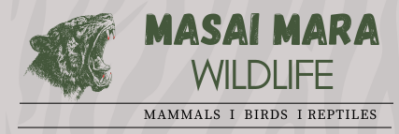- Common Names: Cape Buffalo, African Buffalo
- Scientific Name: Syncerus caffer
- Swahili Name: Nyati or Mbogo
- Maasai Name: Olarro
- Size:
- Head-Body Length (HBT): 4.2 m (14 ft)
- Shoulder Height (SH): 1.7 m (5½ ft)
- Gestation: 50 weeks
Recognition and Appearance
The Cape Buffalo is an unmistakable, imposing animal, often seen in large family herds or smaller groups of bachelor males. Known for their massive, dark bodies and distinct horns, they are one of the “Big Five” in the Masai Mara. The horns of mature males are fused in the center, forming a hard “boss” that makes them stand out. Females tend to be browner, while males are darker, almost black. The calves are chestnut-brown for the first few years.
Habits and Behavior
- Social Structure: Cape Buffalos are social animals, often forming large herds, especially in areas with abundant water sources. These herds can include hundreds of individuals, offering protection from predators like lions. The herds are typically led by dominant bulls, and calves are fiercely protected by the entire group. When threatened, the herd forms a protective circle around the calves, showing their strong group defense instincts.
- Males: Older bulls tend to form smaller bachelor groups and are known for their aggression. These solitary or bachelor bulls are particularly dangerous to humans, as they are often less predictable than those within the herd.
Where to Find
- Habitat: Cape Buffalos are found in a variety of habitats in the Masai Mara, including grasslands, swamps, and wooded savannas. They are dependent on water, and you’ll often find them near rivers and watering holes, where they gather to drink and cool off.
Diet
- Feeds on: Cape Buffalos are primarily grazers, feeding on long grass and rank vegetation. Despite their large size, they are selective feeders, using their large molars to chew tough grasses and their thick, prehensile tongues to rasp plants into their mouths. They spend a large portion of the day chewing cud, making them efficient ruminants.
- Water Dependency: Buffalos need access to water daily, which is why they are commonly found near water sources. They will travel long distances to find water during dry seasons.
Predators and Defense
- Lions: Lions are the primary predators of Cape Buffalos, particularly targeting weaker or isolated individuals. Calves are also preyed upon by leopards and hyenas. However, Buffalos are formidable adversaries and will defend themselves and their young fiercely.
- Group Defense: When faced with danger, Buffalos exhibit a unique behavior by forming a protective circle around their calves, presenting their sharp horns outward. Lions typically avoid engaging with large herds, preferring to hunt smaller groups of bulls.
Reproductive Behavior
- Calving: Females give birth to one calf during the rainy season when food is abundant. Calves are closely bonded with their mothers, who nurture and protect them within the herd. About a month after giving birth, females are ready to mate again, usually with the dominant bull of the herd.
Conservation Status
- IUCN Status: Near Threatened. Cape Buffalos are abundant in protected areas like the Masai Mara, but their populations have been impacted by habitat loss, poaching, and disease. Diseases such as bovine tuberculosis and rinderpest have historically decimated herds. While they are not currently endangered, their dependence on protected areas and water sources makes them vulnerable to environmental changes and human encroachment.
Interesting Facts
- Reputation for Ferocity: Cape Buffalos have a fearsome reputation, being responsible for more fatalities than most other large African animals. Solitary bulls are particularly dangerous, and their unpredictability has earned them the moniker of “the most dangerous animal in Africa.”
- Dominance Hierarchy: In herds, the dominant bull is typically the one with the largest horns, using them in combat to establish dominance. Bachelor bulls who can no longer compete will often leave the herd, forming groups of older males referred to as “dagga boys” (mud boys), which can be highly territorial and aggressive.
In conclusion, the Cape Buffalo is an integral part of the Masai Mara’s ecosystem, known for its strength, resilience, and strong social bonds. Encountering a herd on safari is both awe-inspiring and a reminder of the sheer power of Africa’s wildlife.
